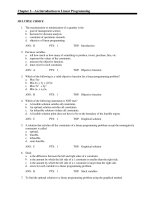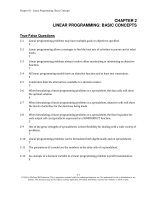Introduction to management science 10e by bernard taylor chapter 01
Bạn đang xem bản rút gọn của tài liệu. Xem và tải ngay bản đầy đủ của tài liệu tại đây (2.22 MB, 28 trang )
Management
Science
Chapter 1
Copyright © 2010 Pearson Education, Inc. Publishing as
Prentice Hall
1-1
Chapter Topics
The Management Science Approach to Problem
Solving
Model Building: Break-Even Analysis
Computer Solution
Management Science Modeling Techniques
Business Usage of Management Science
Techniques
Management Science Models in Decision Support
Systems
Copyright © 2010 Pearson Education, Inc. Publishing
as Prentice Hall
1-2
The Management Science
Approach
Management science uses a scientific
approach to solving management problems.
It is used in a variety of organizations to solve
many different types of problems.
It encompasses a logical mathematical
approach to problem solving.
Management science, also known as
operations research, quantitative methods,
etc., involves a philosophy of problem solving
in a logical manner.
Copyright © 2010 Pearson Education, Inc. Publishing
as Prentice Hall
1-3
The Management Science
Process
Figure 1.1
Copyright © 2010 Pearson Education, Inc. Publishing as
Prentice Hall
1-4
Steps in the Management
Science Process
Observation - Identification of a problem that exists
(or may occur soon) in a system or organization.
Definition of the Problem - problem must be clearly
and consistently defined, showing its boundaries and
interactions with the objectives of the organization.
Model Construction - Development of the functional
mathematical relationships that describe the decision
variables, objective function and constraints of the
problem.
Model Solution - Models solved using management
science techniques.
Model Implementation - Actual use of the model or
its solution.
Copyright © 2010 Pearson Education, Inc. Publishing
as Prentice Hall
1-5
Example of Model Construction
(1 of 3)
Information and Data:
Business firm makes and sells a steel
product
Product costs $5 to produce
Product sells for $20
Product requires 4 pounds of steel to make
Firm has 100 pounds of steel
Business Problem:
Determine the number of units to produce to
Copyright
© 2010 Pearson
Education,
Inc. Publishing
as
make
the
most
profit,
given the limited
Prentice Hall
1-6
Example of Model Construction
(2 of 3)
Variables:
X = # units to produce
(decision variable)
Z = total profit (in $)
Model:
Z = $20X - $5X (objective function)
4X = 100 lb of steel (resource
constraint)
Parameters:
(known values)
$20, $5, 4 lbs, 100 lbs
Formal Specification of Model:
Copyright © 2010 Pearson Education, Inc. Publishing as
Prentice Hall
1-7
mple of Model Construction (3 of 3)
Model
Solve the constraint equation:
Solution:
4x = 100
(4x)/4 = (100)/4
x = 25 units
Substitute this value into the profit
function:
Z = $20x - $5x
= (20)(25) – (5)(25)
= $375
Copyright © 2010 Pearson Education, Inc. Publishing as
(Produce 25 units, to yield a
Prentice Hall
1-8
Model Building:
Break-Even Analysis (1 of 9)
■Used to determine the number of units of a
product to sell or produce that will equate
total revenue with total cost.
■The volume at which total revenue equals
total cost is called the break-even point.
■Profit at break-even point is zero.
Copyright © 2010 Pearson Education, Inc. Publishing
as Prentice Hall
1-9
Model Building:
Break-Even Analysis (2 of 9)
Model Components
Fixed Cost (cf) - costs that remain constant
regardless of number of units produced.
Variable Cost (cv) - unit production cost of
product.
Volume (v) – the number of units produced or sold
Total variable cost (vcv) - function of volume (v)
and unit variable cost.
Copyright © 2010 Pearson Education, Inc. Publishing
as Prentice Hall
1-10
Model Building:
Break-Even Analysis (3 of 9)
Model Components
Total Cost (TC) - total fixed cost plus total
variable cost.
TC c f vcv
Profit (Z) - difference between total
revenue vp (p Z
=
unit
total cost,
vp price)
- c f - vcand
v
i.e.
Copyright © 2010 Pearson Education, Inc. Publishing
as Prentice Hall
1-11
Model Building:
Break-Even Analysis (4 of 9)
Computing the Break-Even Point
The break-even point is that volume at
which total revenue equals total cost and
profit is zero:
vp c vc 0
f
v
v( p cv ) c f
The break-even
point
Copyright © 2010 Pearson Education, Inc. Publishing as
Prentice Hall
v
cf
p cv
1-12
Model Building:
Break-Even Analysis (5 of 9)
Example: Western Clothing
Company
Fixed Costs:
cf =
$10000
Variable Costs: cv = $8
per pair
Price :
p=
$23 per pair
The Break-Even Point is:
Copyright © 2010 Pearson Education, Inc. Publishing as
Prentice Hall
1-13
Model Building:
Break-Even Analysis (6 of 9)
Copyright © 2010 Pearson Education, Inc. Publishing as
Prentice Hall
Figure
1.2
1-14
Model Building:
Break-Even Analysis (7 of 9)
Copyright © 2010 Pearson Education, Inc. Publishing as
Prentice Hall
Figure
1.3
1-15
Model Building:
Break-Even Analysis (8 of 9)
Copyright © 2010 Pearson Education, Inc. Publishing as
Prentice Hall
Figure
1.4
1-16
Model Building:
Break-Even Analysis (9 of 9)
Copyright © 2010 Pearson Education, Inc. Publishing as
Prentice Hall
Figure
1.5
1-17
Break-Even Analysis: Excel
Solution (1 of 5)
Copyright © 2010 Pearson Education, Inc. Publishing as
Prentice Hall
Exhibit 1.1
1-18
Break-Even Analysis: Excel QM
Solution (2 of 5)
Copyright © 2010 Pearson Education, Inc. Publishing as
Prentice Hall
Exhibit
1-19
Break-Even Analysis: Excel QM
Solution (3 of 5)
Copyright © 2010 Pearson Education, Inc. Publishing as
Prentice Hall
Exhibit
1-20
Break-Even Analysis: QM Solution (4
of 5)
Exhibit 1.4
Copyright © 2010 Pearson Education, Inc. Publishing as
Prentice Hall
1-21
Break-Even Analysis: QM Solution (5
of 5)
Copyright © 2010 Pearson Education, Inc. Publishing as
Prentice Hall
Exhibit 1.5
1-22
Classification of Management Science
Techniques
Figure 1.6
Copyright © 2010 Pearson Education, Inc. Publishing as
Prentice Hall
Modeling
1-23
Characteristics of Modeling
Techniques
Linear Mathematical Programming clear objective; restrictions on resources and
requirements; parameters known with
certainty. (Chap 2-6, 9)
Probabilistic Techniques - results contain
uncertainty. (Chap 11-13)
Network Techniques - model often
formulated as diagram; deterministic or
probabilistic. (Chap 7-8)
Other Techniques - variety of deterministic
and probabilistic methods for specific types
of© problems
including
forecasting, inventory,
Copyright
2010 Pearson Education,
Inc. Publishing
as Prentice Hall
1-24
Business Use of Management
Science
Some application areas:
- Project Planning
- Capital Budgeting
- Inventory Analysis
- Production Planning
- Scheduling
Interfaces - Applications journal published
by Institute for Operations Research and
Management Sciences (INFORMS)
Copyright © 2010 Pearson Education, Inc. Publishing
as Prentice Hall
1-25









